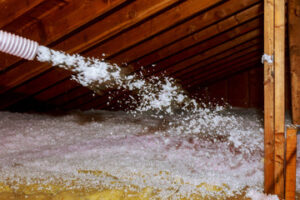Ceiling Insulation Perth keeps heat in during winter and out during summer, reducing energy bills. It also reduces sound transfer between floors, making your home quieter.

Insulating the ceilings of your home is an inexpensive investment that offers great returns. It helps to regulate indoor temperatures, so your heating and cooling systems don’t have to work as hard.
The immediate allure of ceiling insulation is its ability to help maintain a comfortable indoor temperature without the need for constant heating and cooling. This results in lower energy bills and a reduced carbon footprint.
The effectiveness of insulation is measured by its R-value, which indicates its resistance to heat flow. Higher R-values indicate better insulating qualities. Many insulation options exist, including fiberglass batts, cellulose, and foam. Each option has its own advantages. For example, cellulose is a renewable material that can be made from recycled materials such as paper or denim. It is also cost-effective and highly durable. It’s a good choice for homes in cold climates where high heating costs are common.
Another benefit of insulation is its ability to improve indoor air quality. It blocks external pollutants like dirt, radon, and smoke from entering readily accessible areas, such as the living room or bedroom. This helps reduce the occurrence of mold, mildew, and diseases in these rooms. Additionally, some insulation products can also improve indoor air quality by reducing the infiltration of outdoor allergens.
Ceiling insulation can also help reduce the noise levels in a home or commercial building. This is because it acts as a sound barrier, helping to minimize the transfer of noise between spaces. For this reason, it’s an excellent choice for multi-story buildings and locations with high ambient noise levels.
There are a number of ways to insulate your ceiling, but if you’re looking for an efficient and eco-friendly solution, you should consider working with a professional insulation contractor. They’ll be able to help you determine the best type of insulation for your property based on your specific preferences and the climate in which you live.
Comfort
Ceiling insulation is an affordable way to improve your home’s comfort and energy efficiency. When installed properly, it creates a barrier that prevents heat from escaping your home during the winter and keeps the summer sun’s heat out, reducing your reliance on your air conditioning system. Additionally, insulated ceilings reduce the noise caused by traffic and neighbours, creating a more peaceful living environment.
Choosing the right insulation depends on your specific situation and energy goals. There are several options available, including spray foam and cellulose insulation, both of which are highly effective. Spray foam has a high R-value and provides an airtight seal to reduce drafts, while cellulose is made from recycled paper products treated for fire resistance. For the best results, it’s important to have your insulation professionally installed to ensure a proper fit and maximum performance.
Installing insulation at the time of new construction or major renovations is ideal, as it allows access to all areas of the ceiling for proper installation. However, homeowners can also add insulation to existing homes through a range of options. Rigid foam boards, for example, can be cut to size and placed in difficult to reach areas. Spray insulation, on the other hand, expands to fill gaps and cracks, providing a nearly airtight seal and superior energy efficiency.
When installed properly, insulation can save up to 25-30% of your energy bills. It also protects your home from moisture, which can cause a number of problems including mold and mildew growth, and it can increase resale value.
Without insulation, the warmth from your house will escape through the ceiling and roof in the winter and it will radiate into the lower levels of the home, requiring your heating or cooling system to work harder to maintain comfortable temperatures. Insulation can keep your home warmer during cold NEPA winters and cooler in the summer, reducing your dependence on your HVAC system and saving you money. It also helps minimise energy waste and contributes to a sustainable environment.
Reduced Utility Bills
Insulation keeps heat in during the winter and out during the summer, helping you save on your heating and cooling bills. It also reduces air leakage, which can cause your HVAC system to work harder than necessary and significantly increase your energy consumption. Insulation can also reduce noise, creating a more comfortable and relaxing environment. And, if you choose fire-resistant insulation materials, it can slow down the spread of flames and smoke, giving you and your family more time to escape in the event of an emergency.
Upgrading your existing home’s insulation is one of the best ways to lower utility bills and become more energy efficient. However, choosing the right type of insulation and making sure it’s installed correctly is important. If you’re considering adding insulation to your existing home or building a new home, be sure to talk to a professional to learn more about the different types of insulation available and what R-value will be most effective in your specific climate zone.
The most common insulation options include fiberglass, cellulose and spray foam. Fiberglass and cellulose insulation are commonly blown into attics and other hard-to-reach spaces, where they create a dense thermal barrier that prevents heat from escaping. Both of these types of insulation are highly effective at reducing air leakage and lowering your energy bills.
Spray foam insulation, on the other hand, is often installed in walls and attics through holes drilled into the structure. It expands to fill every crack and crevice, creating a tight seal that drastically reduces the amount of air that can leak into your home. Spray foam is also a great option for attic renovations, as it can help to create a more functional space and can increase your home’s value in the market.
Upgrading your existing home’s insulation or installing it in a new build is also an excellent way to qualify for government or energy company rebates. These rebates can be applied to the cost of installation, making it even more affordable. This makes it a great investment for your home, providing a return on your investment and long-term savings on your energy costs.
Increased Resale Value
Upgrading to a high-performance insulation can make the home more desirable in the real estate market, especially among buyers with an eye on greener living. Insulation helps reduce greenhouse gas emissions and saves on energy bills. Combined with other eco-friendly features, a well-insulated house can sell for higher than comparable houses.
The attic is a common source of air leakage in homes, leading to wasted heating and cooling. Installing new ceiling insulation can prevent this, as it acts as a barrier to the hot and cold outside temperatures. This also improves indoor comfort by maintaining a consistent temperature, reducing drafts and reducing condensation that can lead to mold.
In addition to reducing the cost of electricity and fuel, a well-insulated home can lower water heater bills by keeping the water hotter for longer. This also prevents pipes from freezing and bursting, which can cause expensive repairs. Insulation also extends roof life by preventing the development of moisture and condensation.
Adding attic insulation is a simple way to increase the overall value of your home. While there is an upfront investment, the long-term savings and increased resale value significantly outperform most other remodeling projects. The return on investment for this home improvement is usually within one year, which makes it a smart investment.
While many people focus on cosmetic upgrades like a new kitchen or bathroom when it comes to increasing their home’s resale value, the effectiveness of a home’s insulation can be equally as impactful. Having a high-quality ceiling can reduce utility bills and help prospective buyers feel more comfortable when viewing the property, which can be an important factor in making a buying decision.
When choosing the best ceiling insulation, it is essential to consider the material, R-value, installation method, and environmental issues. Fiberglass batt insulation, for example, is an affordable option, with costs ranging from $0.25 to $1.14 per square foot for materials. It’s important to note, however, that the R-value listed on the package may be reduced by as much as 20 percent due to the conductive properties of wood framing. Another great option is spray foam, which is more expensive but has a high R-value and provides a tight seal. Closed-cell spray foam is a good choice for humid areas, as it is moisture-resistant.
